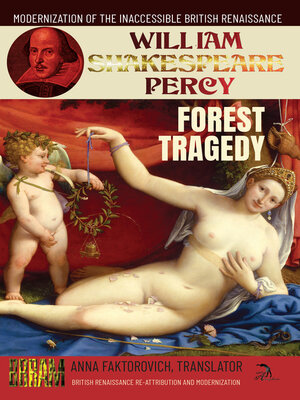A Forest Tragedy in the Vacuum: Or, Cupid's Sacrifice
ebook ∣ British Renaissance Re-Attribution and Modernization, Volume 7 · British Renaissance Re-Attribution and Modernization
By William Percy

Sign up to save your library
With an OverDrive account, you can save your favorite libraries for at-a-glance information about availability. Find out more about OverDrive accounts.
Find this title in Libby, the library reading app by OverDrive.



Search for a digital library with this title
Title found at these libraries:
| Library Name | Distance |
|---|---|
| Loading... |
A farcical satire about the Laws of Tragedy and irrational morality that presents a Vacuum of death. "The Forest Tragedy" is the only text that Percy labeled as a "tragedy", but kept closeted in his family archives, without successfully selling it to a publisher. As the dominant tragedian under the "Shakespeare"-byline, Percy was the master of this genre. After decades of practicing perfecting strict obedience to the Laws of Tragedy, in this experiment, Percy rebels against them and satirizes the "imbecility" behind formulaic rules, and particularly in the types of rules that governs this "cruel" genre. The resulting farce especially satirizes Percy's "Shakespeare"-bylined Romeo and Juliet (1597), as well as other murder-suicide dramas described in "William Painter's" The Palace of Pleasure (1575). Translated segments from Palace about Rhomeo and Julietta are included to assist readers with finding echoes between these three texts. One blatant echo is the "...I die!" speeches uttered by Romeo and by Amadour in the Forest Tragedy. In the latter, events take place seemingly in the duchy of the Vacuum, or a void that brings together characters from ancient times together with historical and contemporary international European monarchs. In its conclusion, the Vacuum consumes all eight of the main characters, and leaves only dead bodies in its void. There is no clear main-character, so it might be Rhodaghond, the black-Egyptian slave-girl who ends up indirectly killing three of her masters because her mistress, Fulvia, shoves her once with her palm. Alternatively, it might be the Jewish boy-scholar and poison-brewer, Jeptes, who obliges his master by creating a poison that eventually kills four. The gore is brought to farcical lows, as three characters drink from a cup of wine with Lord Affranio's heart and the poison in it. Numerous laws of propriety, morality and generic-integrity are not only shattered across this Plot, but these shatterings are also philosophically explained as deliberate decisions of a Poet intent on sacrificing this Plot to prove the absurdity of genre-adhering murder-suicides. There is infidelity, hints of homosexuality, court-intrigue, fraudulent schemes, and a myriad of other dramatic events. And below the surface of the farce, there are beautiful and enticing metered and rhymed poetic passages hitting the heart and soul, as the audience is asked to consider these from the perspective of the omnipotent Poet who has to condemn characters to tragic deaths across decades of a professional writing career.







